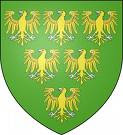One of the charges levied against Piers Gaveston by his enemies was his arrogance and disregard for the nobility. Recalled from exile by Edward II almost as soon as he became king, Piers wasted no time in upsetting the nobility. He did this first at the tournament at Wallingford in December 1307, when the Earls of Warenne, Hereford and Arundel were all defeated. Undoubtedly there were some who were jealous of his title of Earl of Cornwall, his royal bride Margaret de Clare and his intimacy with Edward II. It seemed that Edward could deny his Piers nothing, even the ‘leading role’ at his coronation (Piers dressed in royal purple and carried the crown). Piers had been chosen by King Edward Ist as a good role model for his son, with his gracefulness and good manners especially noted, and it seems Piers brimmed with confidence. This confidence manifested itself in amusing himself and Edward by giving some of the nobles nicknames, which became public and were recorded. The chronicler of the ‘Vita’ says ‘He showed his contempt for the earls and barons by giving them vile nicknames’.
Henry de Lacy, Earl of Lincoln was called ‘burst belly’, Thomas of Lancaster was called ‘the churl’ or ‘the fiddler’, Amyer de Valence, the Earl of Pembroke, was called Joseph the Jew and Guy Beauchamp, the Earl of Warwick, was known as the ‘black dog of Arden’. Whether Piers called his brother-in-law, and the king’s nephew, Gilbert de Clare ‘whoreson’ is open to debate. It would have been incredibly insulting to call Gilbert this, unless there had been some sort of falling out between Piers and his brother-in-law. Gilbert did not come to Piers aid when he was captured after he returned to England after his third exile – he did nothing to help even though he knew Piers was in terrible danger. Did Gilbert realise Piers’ cause was hopeless and threw in his lot with Warwick and the other nobles, even though he knew Edward would do anything to save Piers, and Amyer de Valence was hell-bent on protecting his honour? Did the stinging nickname of ‘whoreson’ help him make up his mind? Maybe there was some sort of dispute between Piers and Gilbert, with Piers choosing to insult Gilbert further by calling him ‘whoreson’.
The other nicknames chosen by Piers for the earls might seem tame by the standards of today – ‘burst belly’ and ‘the fiddler’ seem fairly harmless. But in the context of the times, they were highly insulting – these men were the most high-ranking men in the realm, relatives of the king and men who demanded respect. They must have felt humiliated to have been so ‘teased’ by Piers – and Edward did nothing to reprimand Piers for using these names. You get the feeling that Edward must have laughed in their faces. Politicians are often given nicknames in jest today – John Prescott, former deputy prime minister was called ‘Two jags’ (after his use of ministerial cars) and later ‘two jabs’ after an altercation with a member of the public. Tony Blair has been referred to as Bambi and Miranda. They take it in good humour as there is nothing they can do. But the nobles at Edward’s court were infuriated. The nicknames chosen by Piers may have had something to do with the appearance of the nobles. You can just imagine Lincoln as being somewhat overweight and his clothes seemingly to be bursting at the seams. Lancaster seems to have been given the ‘honour’ of two nicknames. The definition of churl is an ill-bred person lacking refinement or someone who is selfish and unwilling to share. This must have been chosen by Piers as an indication of the character of Lancaster. Did Lancaster resemble a fiddle player? Or was Piers hinting at his manipulative nature? ‘Joseph the Jew’ for Pembroke may well have something to do with Pembroke’s appearance.
The noble who took the most offence seems to have been Guy de Beauchamp, Earl of Warwick. Piers called him the ‘black dog/hound of Arden’. Was this a reference to his physical appearance? Was Piers mocking his temper, in that Warwick may literally have foamed at the mouth in temper? Warwick is alleged to have warned Piers to beware the bite of the ‘black hound’. I have wondered whether there might be more to these nicknames than we realise – was it a sly way for Piers to slander the nobles – were there some hidden meanings in these nicknames that have been lost to us? Or was it that Piers resented the way the nobles ‘looked down’ on him? That they despised his elevation to the earldom of Cornwall, and it was Piers way of ‘taking them down a peg or two’? Or maybe it was a way of Edward and Piers just simply having some fun at the expense of the nobles? Whatever the cause, the nobles were out-raged and chroniclers like the author of the Vita Secundi thought the insults so serious they recorded them.
For further reading on the subject of Piers' use of nicknames, see Kathryn's excellent post from her Edward II blog -












